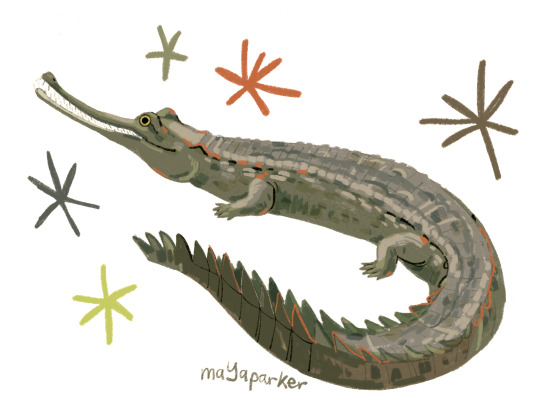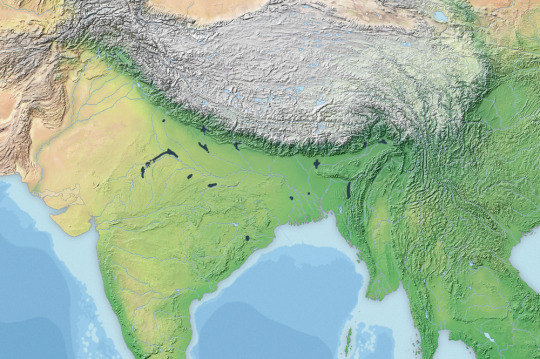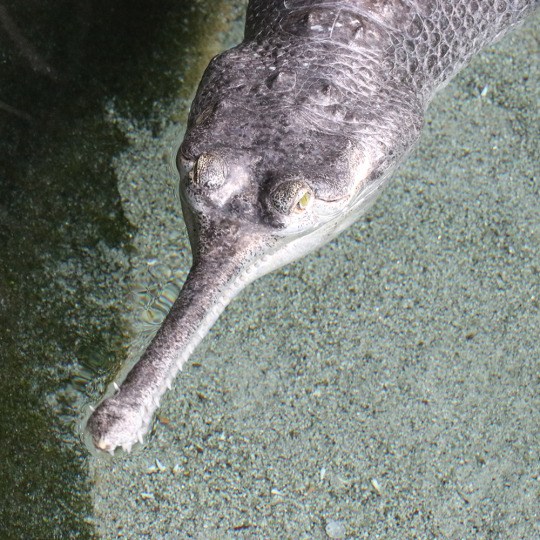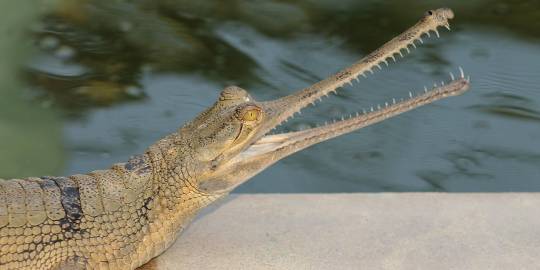#Gavialis
Text

Gharials (Gavialis gangeticus), male with babies, family Gavialidae, National Chambal Gharial Wildlife Sanctuary, India
CRITICALLY ENDANGERED.
photograph by Dhritiman Mukherjee
3K notes
·
View notes
Text

a gharial (gavialis gangeticus) because they are my favourite crocodile!!!!!
189 notes
·
View notes
Text

“Overcast Catch”
Gavialis bengawanicus with it’s captured quarry for #paleonusantara
436 notes
·
View notes
Text
Gharial rescued from sea
Another instance of more recent croc news, a "giant" gharial was found in the Indian Ocean off the coast of Balsore, eastern India.
According to news articles, the animal, an adult Indian Gharial (Gavialis gangeticus), meassured around 13 feet or in metric close to 4 meters in length while weighing some 118 kilos.

The gharial apparently got caught in a fishing net and was found by fishermen, who promptly reported their catch to the Forest Department. The department then handed the animal over to Nandankanan Zoological Park, where the crocodilian still resides.
That's all the information given to us by the article, which you can read here, but there's two key notes I wanna touch upon.
The first is size. At 4 meters, this gharial was decently large for sure and as someone who has seen a (stuffed) female of slightly greater proportions I can attest that it must have been an impressive animal. However, I think its worth mentioning that Indian gharials are capable of growing even larger. The female I just mentioned is accompanied by a stuffed male nearly 5 and a half meters in length, with some reports claiming sizes even greater than that.
Me and the Vienna gharials

The second point is the mysterious presence of a gharial this far out at sea. This is simultaneously unusual yet also very much reasonable from the point of view of paleontology.
On the one hand, Indian gharials are critically endangered. Their range today is incrediply spotty and isolated and to my knowledge they aren't found anywhere near the coast these days.


However when you look at how the range was meant to be like, then you see that they definitely reached the river deltas and coastal regions. So our image of gharials as this inland freshwater species is more based in circumstance than reality.
This becomes especially apparent once you begin to consider the paleobiogeography of gharials. Based on our current knowledge, gharials most likely originated somewhere in Eurasia or Africa, spreading from there across much of the eastern hemisphere and beyond (full disclosure I am not considering thoracosaurs to be gavialoids, more on that can of worms later maybe). Anywho, phylogenetic analysis and the fossil record both suggest that gharials then crossed oceans and settled South America sometime prior to or during the Miocene, where they diversified and gave rise to the gryposuchines. Some species even remained saltwater species, such as Piscogavialis, which lived in the coastal waters of Peru.
Although gryposuchines were once thought to be a distinct subfamily of gharial, recent research suggests that they were but an evolutionary stepping stone, with some South American form once again crossing the Pacific and settling down in Asia where the much more basal "tomistomines" or false gharials (a misnomer) still resided. And while the gryposuchines of South America went extinct, those that returned to Asia survived and eventually gave rise to the Indian Gharial of today.
Left: A cladogram showing the relationship between Gryposuchinae and modern gharials
Right: Piscogavialis swimming overhead some marine sloths of the genus Thalassocnus by @knuppitalism-with-ue


So ultimately, seeing a gharial in saltwater is much less bizarre than one would initially think, its just that habitat destruction and overhunting have largely pushed these gorgeous reptiles further inland and to the brink of extinction.
#gharial#indian gharial#gavialis gangeticus#gavialidae#news#croc#crocodilia#crocodile#india#herpetology#gavialinae#gryposuchinae#piscogavialis#some paleontology#palaeoblr
244 notes
·
View notes
Photo


改めて信じられない形をしている
@東山動植物園
It’s an incredible shape.
@Higashiyama Zoo & Botanical Gardens
243 notes
·
View notes
Photo

The Gharial crocodile (Gavialis gangeticus) uses its slim snout for fishing.
Photo by: Josh More courtesy of ZSL.
87 notes
·
View notes
Text
Think it might be time to go back to gavialis instead of gharialsorcery,,, doing some pondering to that effect
0 notes
Text

🐊 ANIMAL OF THE DAY: the gharial, Gavialis gangeticus, from India. it is like a crocodile but Long? has a snout shaped like a hot dog bun or a hoagie. but not nearly so Delicious, i assume. god, i want a fat ass sandwich right now. i bet a gharial couldn't even help me with that
39 notes
·
View notes
Text


Patreon sketches for gavialis and archades! 🐺
37 notes
·
View notes
Note
May I bring to the table the absolute unit that is the gharial? Pls?
GHARIALS!!!

False Gharial aka Malayan Gharial (Tomistoma schlegelii), family Gavialidae, found in Malaysia, Singapore, and Indonesia
Historically, there has been some disagreement about how this species should be placed. At one time, some herpetologists believed this species should be placed in the crocodile family, Crocodylidae. There is vast agreement now that they should be placed in the Gharial family, Gavialidae.
photograph by Junkyardsparkle

Gharials (Gavialis gangeticus), male with babies, family Gavialidae, National Chambal Gharial Wildlife Sanctuary, India
CRITICALLY ENDANGERED.
photograph by Dhritiman Mukherjee

Gharial (Gavialis gangeticus), female, family Gavialidae, National Chambal Sanctuary, India
CRITICALLY ENDANGERED.
photograph by Charles J. Sharp

Gharial (Gavialis gangeticus), female, family Gavialidae, National Chambal Sanctuary, India
CRITICALLY ENDANGERED.
photograph by Clpramod
370 notes
·
View notes
Text

Range of the gharial in 2019 in black

A miniature illustration of the Baburnama showing a gharial, ca. 1598, National Museum, New Delhi
Adult males have a distinct boss at the end of the snout, which resembles an earthenware pot known as a घड़ा (gharha) hence the name "gharial".
The wild gharial population has declined drastically since the 1930s and is limited to only 2% of its historical range. Loss of habitat because of sand mining and conversion to agriculture, depletion of fish resources and detrimental fishing methods continue to threaten the population.
In 2017, the global population was estimated to comprise at maximum 900 individuals, including about 600 mature adults in six major subpopulations along 1,100 km (680 mi) of river courses and another 50 mature adults in eight minor subpopulations along 1,200 km (750 mi) of river courses.
The genus Gavialis probably originated in the region of India and Pakistan in the Early Miocene. Fossil gharial remains excavated in the Sivalik Hills of Haryana and Himachal Pradesh are dated to between the Pliocene and the Early Pleistocene.
The earliest known depictions of the gharial date to the Indus Valley civilisation. Seals and tablets show gharials with fish in their mouths and surrounded by fish. A tablet shows a deity flanked by a gharial and a fish. These pieces are about 4,000 years old and were found at Mohenjo-daro and Amri, Sindh.
A gharial is depicted on one of the rock carvings on a pillar of the Sanchi Stupa, which dates to the 3rd century BC. In Hindu mythology, the gharial is the vehicle of the river deity Gaṅgā and of the wind and sea deity Varuna.
In the 16th-century book Baburnama, Zahir-ud-din Muhammad Babur accounted of a gharial sighting in the Ghaghara River between Ghazipur and Benares in 1526.
#i knew they were endangered i didn't realise how lucky i was to have seen one (captive)#i was at sanchi too but i didn't catch this illustration or maybe it's significance#i tried to look up the best transliteration for ड़ and wiki just said no equivalent in english
25 notes
·
View notes
Text

Komodo dragon Varanus komodoensis
See, if you'd told me yesterday morning, before I started looking at reference pics, that komodo dragons were this colour- and patternful, I probably wouldn't have believed you. In most pictures they just look brown. But like!

I suspected this mans was freshly peeled at first and that's why he was so vibrant, but then of course I looked closer and. He's literally peeling at the moment. (This is my own picture btw, I just. Forgor.)
Or the zoo lied and it's a whole different monitor lizard lol.
Anyway! Check out my growing digital art zoo here, and tell me...
You can look them up or go by vibes :D If someone suggests something else and it doesn’t win, I’ll add it to my list for the future!
#komodo dragon#art#artists on tumblr#reptile#varanus komodoensis#monitor lizard#digital art#my art#digital zoo
14 notes
·
View notes
Text


9 notes
·
View notes
Text
10 Lesser-Known Animals and Their Unique Eating Habits 🦜🌿
Aye-Aye (Daubentonia madagascariensis)
Habitat: Madagascar 🌴
Diet: Insects, particularly wood-boring grubs 🪲
Feeding Habits: The aye-aye uses its long, thin middle finger to tap on trees to locate hollow chambers where grubs reside. Once a grub is located, it gnaws a hole in the wood with its forward-slanting incisors and uses its elongated finger to extract the grub. 🦷👆

Blobfish (Psychrolutes marcidus)
Habitat: Deep sea, off the coasts of Australia and New Zealand 🌊
Diet: Crustaceans, sea urchins, and other deep-sea creatures 🦀
Feeding Habits: The blobfish lacks muscles, so it doesn't actively hunt. Instead, it floats along the sea floor, opening its mouth to suck in any edible matter that drifts by. 🍽️

Pangolin (Pholidota)
Habitat: Various habitats across Asia and Africa 🌍
Diet: Ants and termites 🐜
Feeding Habits: Pangolins have long, sticky tongues that they use to probe ant and termite nests. They have strong claws to break into the nests and a sticky tongue to lap up the insects. 👅

Gharial (Gavialis gangeticus)
Habitat: Rivers in the Indian subcontinent 🌊
Diet: Fish 🐟
Feeding Habits: The gharial has a long, narrow snout filled with sharp teeth, perfect for catching fish. It uses a swift side-to-side snapping motion to catch fish swimming by. 🐊

Star-Nosed Mole (Condylura cristata)
Habitat: Wet lowland areas in North America 🦔
Diet: Small invertebrates, aquatic insects, worms 🪱
Feeding Habits: This mole uses its star-shaped nose, covered in sensory receptors, to detect prey. It can identify and consume small prey in a fraction of a second. 🌟

Hoatzin (Opisthocomus hoazin)
Habitat: Swamps, river forests of the Amazon Basin 🌳
Diet: Leaves and vegetation 🍃
Feeding Habits: The hoatzin has a specialized digestive system that ferments vegetation similar to a cow’s stomach. It spends hours digesting leaves in its crop, a part of its digestive tract. 🐦

Numbat (Myrmecobius fasciatus)
Habitat: Eucalyptus forests in Australia 🌏
Diet: Termites 🐜
Feeding Habits: Numbats use their long, sticky tongues to probe into narrow crevices and galleries within termite mounds. They can eat up to 20,000 termites a day. 👅

Leafcutter Ant (Atta spp.)
Habitat: Tropical rainforests in Central and South America 🌲
Diet: Fungi that they cultivate 🧫
Feeding Habits: Leafcutter ants cut leaves and carry them back to their nests, where they use the leaves to grow a special fungus, which serves as their primary food source. 🍄

Purple Frog (Nasikabatrachus sahyadrensis)
Habitat: Western Ghats of India 🌄
Diet: Termites 🐜
Feeding Habits: Spending most of its life underground, the purple frog comes out only during the monsoon season to breed. It uses its specialized tongue to feed on termites in underground colonies. 🐸

Vampire Finch (Geospiza difficilis septentrionalis)
Habitat: Galápagos Islands 🌴
Diet: Blood of other birds, insects 🌿
Feeding Habits: The vampire finch pecks at the skin of larger birds like boobies to drink their blood. This behavior likely evolved due to scarce food resources. 🦜

These lesser-known animals each have unique and fascinating feeding habits that highlight the incredible diversity of the natural world. 🌍✨
#animals#plants#forest#animal#wildlife#planet#nature#nature photography#naturelovers#natureconservation#animal protection#animal print#animal products
7 notes
·
View notes
Text




Commissions Icon for
Dallathor (First and Last)
Gavialis
Maxim
#drawing#digital drawing#drawings#commission art#art commisions#character art#digital art#digital commisions#furry character#cute furry#furry#cute art#adorable#cute illustration#cute animals#colorful
4 notes
·
View notes
Text
Hello everyone! Damn, the paddlefish article has really brought a lot of new folks to this blog! Welcome everyone, and thank you so much for joining this lovely little project of mine--I am so grateful that so many people have taken an interest in my work and in the species I want to help protect.
Since there are so many new folks here, I wanted to give a brief rundown on the articles I've written so far. In the last year and a half of this project, I've been able to write about seventeen awesome and unique species that are in need of further conservation attention. Here are some links to learn more about them:
Olm (Proteus anguinus): the OG and mascot for the site, this eyeless salamander manages to survive in its pitch-dark cave biome through incredible sensory abilities and supernatural patience.
Indian Purple Frog (Nasikabatrachus sahyadrensis): this comically-ugly creature is also incredibly mysterious, spending its entire life underground and only emerging for a single day each year.
Pygmy Hippo (Choeropsis liberiensis): this secretive, pig-sized mammal is the only surviving relative of the mighty river hippo, but lives a completely different lifestyle from its much more famous cousin.
Scaly-Foot Snail (Chrysomallon squamiferum): one of the weirdest animals on the planet, this snail grows a shell reinforced with iron and lives around hydrothermal vents deep beneath the surface of the Indian ocean.
Kaua'i Cave Wolf Spider (Adelocosa anops): this blind cave spider is one of the rarest arthropods on Earth, and lives in tunnels carved by lava flows beneath the surface of the Hawaiian Island of Kaua'i.
Shoebill (Balaeniceps rex): this huge African water bird uses its tremendous beak like a guillotine to smash and decapitate its prey.
Largetooth Sawfish (Pristis pristis): this relative of sharks and rays has a tremendous nose lined with teeth which it uses to dig up and swipe at prey, but that's not the only thing its nose is good for.
Takin (Budorcas taxicolor): this large goat relative is quite possibly the most mysterious large land mammal on Earth, as it lives deep in the forested mountains of China, India, and Bhutan.
Zacatuche (Romerolagus diazi): also known as the "volcano rabbit", this adorable little fellow is an excellent gateway into understanding the benefits of grasslands to ecosystems and human settlements alike. Done in collaboration with Mexico'a CONANP.
(tambien en español)
Secretarybird (Sagittarius serpentarius): this badass raptor stalks the African savannah, using its powerful legs to deliver one of the fastest and most accurate kicks in the animal kingdom (and yes it's also the bird from Aggretsuko).
Manchineel (Hippomane mancinella): the first plant written about on Consider Nature (though certainly not the last), the manchineel is quite possibly the most toxic tree in the world, with every part of its anatomy steeped with a variety of noxious substances.
Gharial (Gavialis gangeticus): this crocodilian is a fish specialist, using its long, slender snout like a rapier to cut through the water and snag its prey.
Vaquita (Phocoena sinus): the most-endangered mammal on the face of the Earth, the Vaquita is a tiny porpoise that has gotten caught up in the black market trade of an extremely valuable fish bladder. Done in collaboration with Sea Shepherd International.
Pekapeka (Mystacina tuberculata): this tiny bat species is one of only 2 mammals native to New Zealand and spends more time on the ground than any other bat species in the world, despite being able to fly.
Angular Roughshark (Oxynotus centrina): this shark is native to the coasts of Western Europe and Africa, where it lives over a thousand feet beneath the waves and is rarely seen by people.
Marine Iguana (Amblyrhynchus cristatus): these iguanas are the only seafaring lizards in the world, and have developed a variety of remarkable adaptations to survive the extreme conditions of the Galapagos Islands.
And as always, if you have any suggestions, questions, or just want to say hi, you can DM me here or email me at [email protected]. Welcome, and thank you for your support.
4 notes
·
View notes